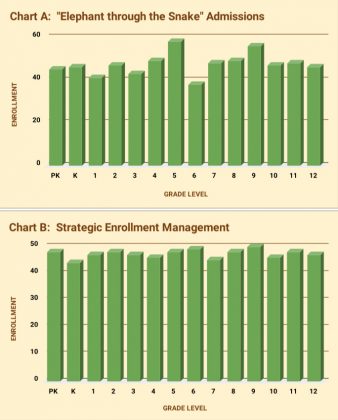Avoid the Elephant through the Snake
While admissions officers recruit and enroll students, academic administrators and faculty provide the educational experience of students at the core of a school’s identity. So academic staff rely on admissions officers to manage enrollment strategically, rather than merely admitting as many students as possible across grade levels in any given year. Simple math does not suffice when multivariate Calculus does better to ensure that admissions strategies match institutional priorities and needs.
 Significant enrollment changes from year to year create added challenges for academic staff as they do their part in pursuit of a school’s mission. To academic staff, a large class bookended by smaller classes is like watching a snake eat an elephant: in both snake and school, you can watch as the mass works its way through with obvious consequences. Likewise, a small class bookended by much larger classes can wreak havoc on the academic staff. (See Chart A’s peaks and valleys versus Chart B’s more stable and consistent enrollment.)
Significant enrollment changes from year to year create added challenges for academic staff as they do their part in pursuit of a school’s mission. To academic staff, a large class bookended by smaller classes is like watching a snake eat an elephant: in both snake and school, you can watch as the mass works its way through with obvious consequences. Likewise, a small class bookended by much larger classes can wreak havoc on the academic staff. (See Chart A’s peaks and valleys versus Chart B’s more stable and consistent enrollment.)
While every school has some degree of year-to-year variation in class size, understanding model numbers at each grade level and reshaping marketing and admissions strategies each year in their pursuit helps avoid grade- level enrollment peaks and valleys. Strategic enrollment management that maintains smooth transitions from one class to the next helps academic staff in important ways.
Finances
The first, and most obvious, impact of admissions on academics is through school finances. Admissions success, or lack thereof, goes straight to the budget bottom line and revenues for the fiscal year that affect schoolwide staff size. More students than expected provide extra resources for a school. However, schools failing to reach their budget targets may have to say goodbye to teachers in July or August. Administrators hate having to choose which teachers to release and which programs to cut, especially just before school starts.
Enrollment by Grade
Admissions outcomes also affect enrollment by grade. When sorting out enrollment peaks and valleys in different grade levels, principals have to rework class and section sizes. For example, both teachers and parents expecting classroom sizes to top out at 24 push back when principals schedule some at 30 or more while others have 10 or 12 students.
Staff Allocation by Grade
Similarly, admissions impacts staff allocation by grade as principals try to keep up with the elephant with yearly adjustments to the grade levels, preps, and numbers of sections assigned to teachers. This also inhibits bigger- picture, more strategic efforts to build a strong, sensible, consistent curriculum as programs remain in a frenzied state of “this is what we were able to manage this year.” Ultimately, this can even impair faculty retention efforts as frustration with regularly shifting between grades, subjects, and preps wears out good teachers who end up seeking new schools.
Scheduling Students
Scheduling courses and sections also becomes more difficult when numbers have a high variance from grade to grade. Elephant classes dominate master schedules, leaving other grade levels with fewer teachers in fewer sections to allow students to schedule the courses they need.
Purchasing Curricular Materials
Purchasing or allocating curricular materials can be smooth, efficient, and cost-effective; or the elephant through the snake can kill that prospect. When academic administrators make multi-year purchases of curriculum materials, they must buy for the largest class going through the term of the purchase. So one class significantly larger than the smallest class, as in Chart A, means spending significantly more to supply those students with curricular materials as they work through the grades than if all grades were roughly the same size.
Academics Can Help Admissions Help Academics
Of course, the relationship between Admissions and Academics is not unidirectional. As admissions staff seek to help academic staff do what they do by keeping the elephant out of the snake, academic staff must realize their role in helping admissions officers help them. The key to this is lots and lots of communication and collaboration.
Teachers and principals can impact positively or negatively the experience of prospective families visiting campus. As families visit classrooms on tours, prospective students spend shadow days on campus, visitors come to campus for events, and school personnel present themselves off campus, teachers and principals serve as de facto ambassadors of the school whose actions and behaviors tell people whether the school community is one they want to join.
Academic staff who understand their roles as admissions officers support recruiting mission-appropriate students with their daily actions. Academic staff can also help admissions officers with admissions testing. Admissions staff often do not come from academic backgrounds, and so could benefit from the input of academic staff who interpret testing results (if not conduct the tests themselves).
Schools with enrollment management committees bring admissions and academic personnel together to ensure everyone is on the same page regarding the big picture, strategies, grade level goals, and even talking through specific decisions to admit a prospect or not. This can help considerably in finding, recruiting, and admitting mission-appropriate students that enhance the student body, and in increasing the strategic level of schoolwide enrollment management.
Two things can help considerably in such efforts to manage enrollment by grade level and minimize the chance of sending an elephant through the snake. First, admissions officers must know and follow the school’s mission to find mission-appropriate students and sell them on the school. A school’s mission guides admissions staff to present “bells and whistles” facets like flashy buildings and athletics facilities – in ways that complement, if not feature, what is most important to school identity instead of as fancy distractions from it.
Second, the marketing plans admissions staff implement should be comprehensive, proactive, and data- driven so that admissions efforts seek students in the grades and programs where they are needed most and not where they are not. By seeking mission-appropriate prospects; avoiding the elephant through the snake with strategic enrollment management; and collaborating with faculty and principals to make admissions an all- school endeavor, admissions officers can help academic staff succeed in their school’s foundational and defining activity: educating students.
















 All Services
All Services





